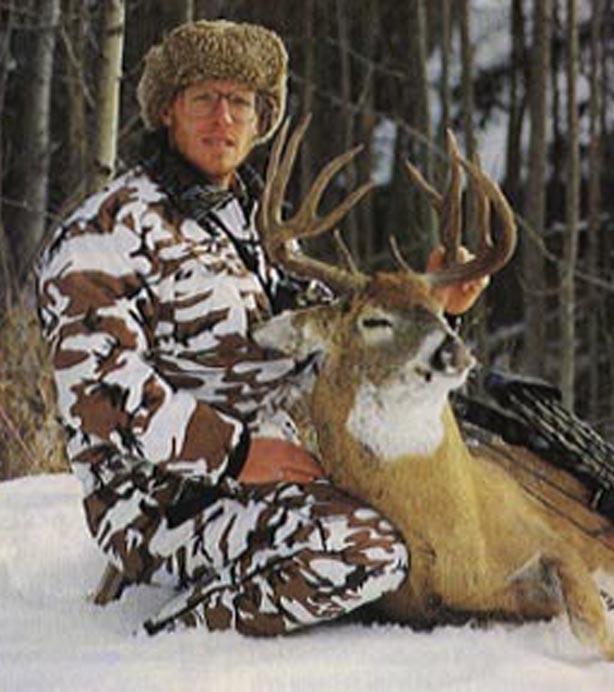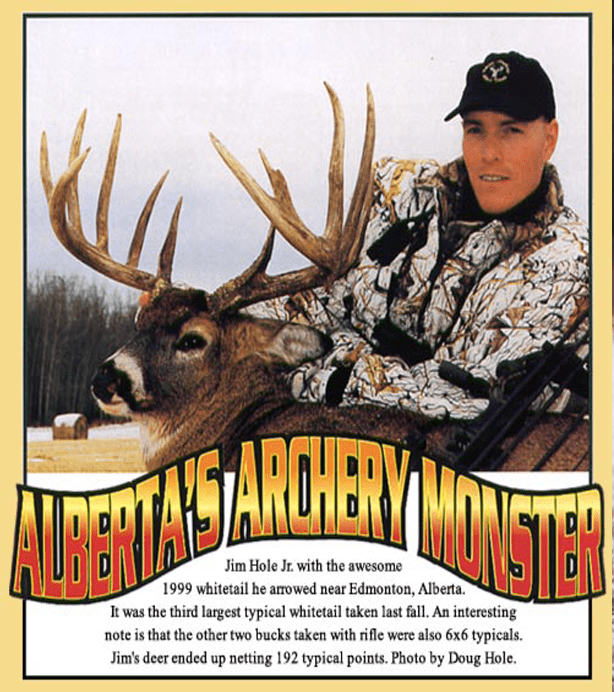Small Details for Big Farmland Bucks
by Jim Hole, Jr.
(Buckmasters Whitetail Magazine, August 1991)
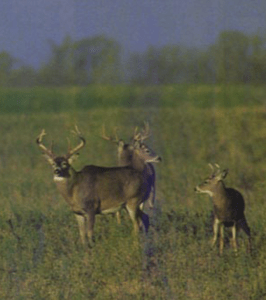
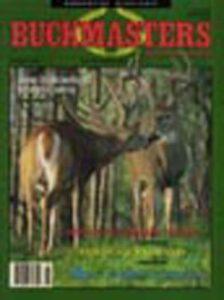
Bowhunting for trophy whitetails is considered the ultimate challenge by many hunters. Surprisingly enough, however, taking a trophy whitetail can be a relatively easy task if a hunter pays absolute attention to detail and proceeds with a predetermined plan.
There are many obstacles which stand between success and failure of the trophy whitetail bowhunter, but none of which can’t be overcome if the hunter follows practical guidelines. The following tips and techniques are of extreme importance in getting a hunter an opportunity at a trophy whitetail. Here are my six pet tips and their applications.
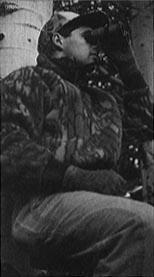
Scouting
One of the most important components which the whitetail hunter faces is scouting. If the hunter is capable of locating a good whitetail and analyzing its pattern without disturbing the natural travel routes, he is well on his way to taking his trophy. The problem which many hunters face is their failure to set up and watch a particular buck from a distance. It seems that the average hunter doesn’t exercise the patience needed to scout out the bow range. Although many hunters feel their time is best spent in a stand where they may get a shot at the deer they are hunting, the chance of success greatly increases when the deer’s travel routes are analyzed at a distance and then hunted at a later time.
In order for the hunter to watch from a distance, a tree stand and binoculars are required. In areas where deer have experienced some hunting pressure, the transition from bedding to feeding area usually occurs during the evening in dim light. This is when the hunter requires high quality binoculars with good light-gathering ability.
Generally, binoculars should have an exit pupil of at least 5mm which is the maximum pupil size of the human eye. For example, a pair of 7×50 binoculars has an exit pupil of 7.15mm, which is calculated by dividing 50 by seven. Compact binoculars have a limited low light ability. For example, 7×26 binoculars have an exit pupil of 3.72mm, which results in reducing the low light visual ability of the hunter.
A binocular which has been used extensively on Alberta hunts is the 8×30, which is very bright in low light and very convenient due to its compact design.
To illustrate the point of scouting from a distance, I recall one hunt from the fall of 1989. At dusk, a non-typical appeared 75 yards from where he was expected. The buck traveled out into the alfalfa field and began to feed for the night. Leaving the area as quietly as I approached it, the buck never knew he had been watched.
Once the pattern has been analyzed, it then becomes easy for the hunter to select an appropriate stand site and wait for the proper conditions to hunt the particular buck for the first, and hopefully only, time. My long distance spotting proved just the ticket for my hunter, John Trout, Jr., who later bagged that very buck.
Preserving a Site
Once the hunter has done his homework and has found what he feels is a productive site, it then becomes very important to preserve the site until productive hunting conditions prevail. In the case of John Trout’s hunt, the buck was left until conditions were exactly right and success came on the first attempt. John rattled in the 154-4/8, 260-pound whitetail, and took him at 18 yards.
One of the most common mistakes made by hunters is hunting a would-be productive site prior to having ideal conditions and subsequently spooking the deer. Alarming the deer educates the animals and in most cases puts the hunter back where he began, having to locate another productive site. Mature whitetails are the most sensitive to any disturbance. Smaller bucks and does may be alarmed in some instances and within 24 hours, return to their normal travel patterns. The trophies, however, very rarely return quickly to their normal patterns after being alarmed. Some Alberta whitetails I’ve observed were spooked in September and did not return to their normal travel routes until late November or December.
One technique which has been very useful on trophy hunts has been to have several different stands in place offering the hunter several options. For example, one stand may be ideal for a northwest wind while another stand may be best for a southeast wind. This will accommodate the hunter for either wind direction. Under no circumstances should as hunter enter a stand unless the wind is favourable for that specific stand.

Wind Analysis
Most hunters agree that the whitetail’s most difficult sense of escape is his sense of smell. If a buck sees or hears something, in many cases he will remain still to further investigate; but if a hunter’s scent is carried to the nose of a whitetail, it will almost always leave the area without hesitation.
A successful bowhunter must be efficient in analyzing wind direction in order to play the game in his favour, rather than the deer’s. Most hunters are well aware of staying downwind of game, but at times this can be a difficult task. One such time is Alberta’s early bow season which runs during the months of September and October. Typically during the season, temperatures vary from 10 degrees to 75 degrees Fahrenheit. During cooler weather, winds are usually consistent and easy to work with, but in warm temperatures inconsistent winds can present the hunter with quite a challenge.
A typical scenario is an alfalfa field in which a hunter has located a good buck. During the warm evening hunt, the wind is light but consistent until the sun settles below the horizon. At his point the change in air temperature almost always causes wind direction to reverse. What seemed to be an ideal setup has now turned into the hunter’s worst nightmare. If he’s smart he will observe from a distance. Attempting to hunt the buck under those circumstances will probably spook the buck and spoil the location. This is an example of how a good site can be ruined by hunting in marginal conditions such as warm weather.
There are two solutions to this problem. The first is to not hunt the site until cooler weather prevails, or to hunt during the warm weather but wait until just before sunset to get into position he will have little time to hunt, and he must be able to get to his stand quickly. Also, due to the hunter’s late arrival, deer may be spooked by his approach. Luckily, there is a solution to getting a hunter to his stand quickly in farmland country.
Using a Vehicle
Fortunately, in farmland areas all of the deer, including mature bucks, are very familiar with farm vehicles and motorized travel. Almost all hunters have witnessed how alarmed a deer becomes by a human walking nearby, as opposed to a vehicle traveling in the same area.
Incorporating a vehicle into some hunting situations can be a very effective tool if done properly. There is no doubt the most effective way to set up on a mature whitetail is with no disturbance whatsoever, but in the event of a hunter trying to get into position late, a vehicle can be a great asset.
An example which illustrates the value of using a vehicle occurred on September 13, 1989. Fellow Alberta bowhunter Ken Elder and I were hunting Edmonton’s Bow-Only zone. The temperature was in the mid-70s; very hot by Alberta standards. We arrived at the alfalfa field 2-1/2 hours before dark. Two stands were placed in predetermined locations and left until just before sunset. As the sun dropped below the horizon, the air cooled and the wind reversed, which allowed both stands to be quickly occupied thanks to a quick drive to the stand sites in a vehicle. Now with favourable conditions prevailing, both hunters were in place. Within 20 minutes, four bucks appeared and fed within 18 yards of my stand. A well-placed arrow took the best of four bucks: a non-typical, 16-point, 260-pounder.
There is no doubt that in this particular case, an early hunter would have been easily detected. The wind had done a complete 180 degree switch which would have scented the bedding area. Although the vehicle can be an effective tool as discussed in this case, there are times when a hunter has consistent winds and an approach on foot can be the best method.

Approaching a Stand
Hunters must understand the general travel routes of the deer they intend to hunt in order to get to a tree stand with no disturbance. Not only must the hunter keep his stand site advantageous with respect to wind direction, he must also keep his route of travel from carrying any scent to the deer he is about to set up on.
As the hunter travels toward his stand on foot, a scent trail is laid down step after step. It is very important to use footwear with a rubber bottom, especially for stand hunting. The rubber bottom helps to minimize the transfer of odours from the foot to the ground. Also, this pair of boots should only be used for hunting in order to keep all foreign odours to minimum.
Walking to the tree stand requires a certain amount of work. Dress for travel should always be light to minimize perspiration. Also, a small backpack should be used to carry warm clothes and gear for ease of travel. It does a hunter no good to wear clean clothes if he sweats them up during travel and transmits a strong odour on the stand.
One of the most important aspects of stand hunting is when to travel to and from the tree stand. Most hunters have learned to travel to a stand during the animal’s bedding time for the evening hunt, but very few hunters exercise the patience to wait and leave a stand once the deer have cleared the immediate area after dark. If departure from the stand takes place when deer are in hearing distance, it takes little time for the bucks to pattern the hunters and stay clear of the stand. Good low light binoculars are essential for the hunter to check the immediate area and to make an undetected departure. Mature bucks seem to have a great talent for locating tree stands and staying well out of bow range. For this reason, it is imperative that a hunter makes the utmost effort to keep his stand a secret.
Stand Sites and Installation
Placing a tree stand for a bowhunter which does not affect the travel patterns of deer frequenting the area is a challenge. The hunter has two options at his disposal. First, the stand can be placed just prior to its use so a buck has no opportunity to find the stand or a stand can be placed and left until the deer becomes used to its presence.
However you intend to set up your stand, there are a few things which can help to minimize disturbance. First, use a small pack to carry your tree stand tools. Your tools should include rubber gloves, limb shears and a limb saw.
The rubber gloves are used to install steps and clear limbs without leaving scent. It would be pointless to install a scentless stand and steps and cover them with human odour in the process. The limb shears are used to trim only the necessary branches. The limb saw is used to clear large branches which can’t be cleared with the smaller shears. The limb saw leaves more scent behind as it produces sawdust. Shears make a clean cut and create less odour from the tree. Be sure to leave no foreign odours at your stand, such as garbage or urine.
If a vehicle is used to take you to your stand site, odour can be drastically reduced by working right from the vehicle, never touching the ground during installation. It is important to place the stand making as few changes to the area as possible.
The consistently successful trophy whitetail bowhunter must pay grave attention to detail. There have been countless stories told of how close a hunter has been to capitalizing on his opportunity when the smallest detail quickly ended what seemed to be an almost sure-fire thing. The dedicated whitetail enthusiast must continually strive to put all he can in his favour to minimize the problems which can arise when closing in on his chance of a lifetime. When it comes to whitetails, it’s the details that cost you.
